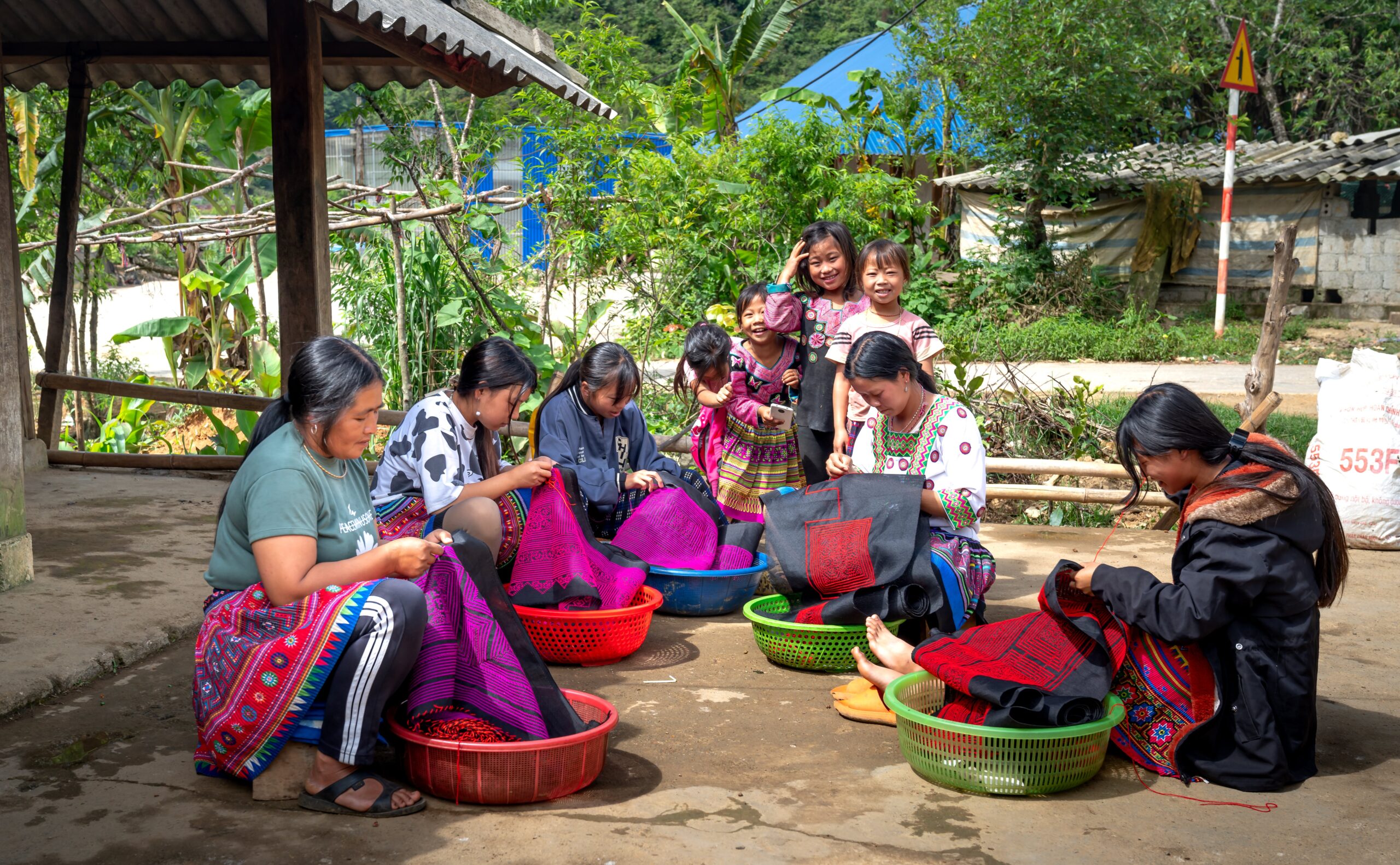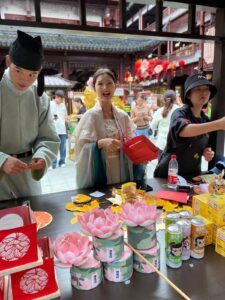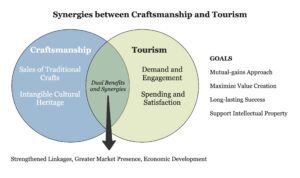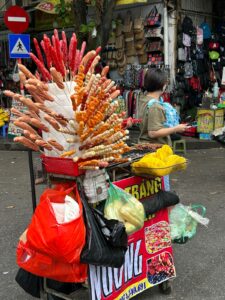
Local Artisans and Craftsmanship Revival Through Tourism

Local Artisans and Craftsmanship Revival Through Tourism
Artisan development and craftsmanship are important tools for local economic development and job creation. Tourism has helped restore and close the disconnect between rural and urban craftsmen and their networks and markets. The increased influx of visitors has provided artisans with a greater market presence and demand for their goods and services, pushing their craft businesses to new heights of success and sustainability.
However, there remains the potential for greater promotion of these economic activities within the tourism sector. As well as the preservation of crafts by bringing in opportunities to local artisans. By working closely with artisans, we can capitalize on and promote their existing traditions and artistic products. Let’s ensure that these valuable cultural assets are preserved and shared with a wider audience. Together, we will explore the dual benefits and synergies that emerge through local artisans and craftsmanship and tourism. Craftsmanship not only invites tourism and destination development through the authenticity and uniqueness of its attractions, but tourism also supports local artisans and cultural entrepreneurs, fostering shared prosperity. Join us in celebrating the resilience of cultural heritage and sustainable tourism. Discover how local artisans create a sense of identity, belonging, and community cohesion.

Preserving Heritage: Traditional Craftsmanship and Architecture in Old Cairo, Egypt
Celebrating Intangible Cultural Heritage
The year 2023 marks a significant milestone in the world of cultural preservation. We celebrate the twentieth anniversary of the Convention for the Safeguarding of the Intangible Cultural Heritage, adopted on October 17, 2003, by the 32nd session of the General Conference of UNESCO. Honoring cultural identities bridges the gap between different social groups. It also leads to upward mobility. This anniversary provides a unique opportunity for all to raise awareness about the diversity and richness of intangible cultural heritage and in fostering international cooperation.
What are Tangible and Intangible Cultural Heritage?
Cultural heritage is a broad term that includes tangible and intangible expressions of human culture:
- Tangible cultural heritage refers to physical objects and areas with societal significance, such as archaeological sites, museum collections, landmarks, and, for example, the places that are listed on the World Heritage List. These can be preserved and transmitted to future generations through conservation, restoration, and education.
- Intangible cultural heritage, on the other hand, refers to traditions or living expressions and practices. It includes performing arts, rituals and festivals, traditional knowledge and skills to produce crafts, and languages. Because intangible heritage is constantly recreated, it is transmitted through oral transmission, apprenticeship, and participation.

Shanghai’s Intangible Cultural Heritage: Handcrafting Traditions in China
Artisanal Preservation, Conservation, and Sustainability
As custodians of intangible cultural heritage, there is a need to grow the socioeconomic status of artisans. We need to protect traditions and promote the development of sustainable practices. Artisanal crafts play a significant role in conservation efforts by fostering ecological and cultural preservation. Traditional tribal crafts provide alternative income sources for local communities, reducing their dependency on forest resources for subsistence. This, in turn, helps mitigate the current social-ecological crisis while promoting the renewal of biodiversity and cultures.
Furthermore, maintaining cultural diversity in the face of growing interconnectedness and globalization can help with intercultural dialogue while encouraging inclusive thinking and mutual respect for other ways of life. Local artisans pass down their knowledge, skills, and craftsmanship from one generation to the next. Their work is not only about creating beautiful products. It’s about sustaining the stories, rituals, and practices that define who we are as a society.

Narrative Artistry: Unveiling China’s Vibrant Performance Traditions
Unlocking the Power of the Creative Economy
The creative economy, as a set of art and culture, design, and innovation industries, creates job opportunities and stimulates economic growth. It promotes entrepreneurship in the cultural sector, leading to an overall diversification of national economies. The creative economy contributes contributes just over 6.1% to the global gross domestic product (GDP), averaging between 2% and 7% of national GDPs worldwide.
Creative assets have untapped potential to deliver socially inclusive, competitive, regenerative, and economic benefits for cities and communities. Cultural and creative industries are at the heart of the creative economy and make cities more attractive places for both residents and visitors.
Understanding Cultural and Creative Industries
Cultural and creative industries are economic activities that enable culture and creativity to contribute to and promote rural-urban and socio-economic development. These industries safeguard local ownership and contribute to social cohesion at the grassroots level. They enable creative networks to develop and create opportunities for marginalized communities and individuals who are often economically excluded.
According to estimates from UNESCO, the cultural and creative industries currently provide nearly 30 million jobs worldwide and employ more people aged 15−29 than any other sector. Nearly half of the people working in the cultural and creative industries are women. This opens up new opportunities to address gender inequalities and women-focused investments.

Empowering Artistry: Women Crafting in West Bangalore, India
In 2021, the European Union expanded its Creative Europe programme, which now includes a budget of € 2.44 billion, compared to € 1.47 billion of the previous programme (2014-2020). The objectives of the programme are to enhance European cultural and creative industries, which, as expressed by the European Commission, include:
- Architecture
- Libraries and museums
- Design and artistic crafts
- Audiovisual, including radio, music, and visual arts
- Tangible and intangible cultural heritage
- Festivals and performing arts
- Literature, books, and publishing

Tokens of Remembrance in Paris, France: Cultural and Creative Industries in Souvenir Craft
The Organisation for Economic Co-operation and Development (OECD) highlights the significant social impacts of cultural and creative sectors and industries, from supporting health and well-being to promoting social inclusion and local social capital. UNESCO and the World Bank have developed a Cities, Culture, and Creativity Framework to support cities in unlocking the power of cultural and creative industries for sustainable urban development, city competitiveness, and social inclusion.
Leveraging Tourism to Support Cultural Products, Values, and Heritage
Cultural and creative industries offer tourists an emotional experience that is different from tangible cultural heritage. Today’s high-value travelers seek authentic cultural experiences. Visitors want to go beyond just visiting landmarks and monuments. They want to experience the social practices that shape cities’ identities and cultures.
Fostering Tourism and Empowering Artisans
Cultural heritage and sustainable tourism preserve and celebrate authentic cultural expressions while fostering inclusive growth and community well-being. When tourism underpins cultural and creative industries, artisans are empowered. Their practices and customs are supported. This fuels economic vitality and establishes a relationship between cultural preservation and sustainable destination development.

Beijing’s Artistic Heritage: Handcrafts in China
Solimar’s Craft and Tourism Program improves the cohesion between the craft and tourism sectors. It does so by creating stronger linkages between the two along an integrated value chain. At Solimar, we recognize the dual benefits and synergies that exist between craftsmanship and tourism. By increasing access to the tourism market, artisans can grow their revenues and profitability. We thus link tourism demand with craft supply, creating direct linkages between craft and tourism experts and developing integrated marketing and promotion tools to help with destination planning. This, in turn, invites tourists and strengthens the networks and circuits in and around craft workshops. As a feasible strategy for local economic development, it allows the craft producer to build relationships with tourists. It also promotes and sustains traditional craft production practices.

The Importance of Diversification and Innovation in Destination Development
Handcrafts remain an important tool in traditional craftsmanship. Tourists often buy different products to take home as souvenirs or gifts. However, many tourists want to have a varied and rich experience that extends beyond handcrafts and towards gastronomy, performances, local costumes, traditional-style homestays, vernacular architecture, and all other cultural and creative industries that specialize in any particular tourism destination. This fills the hearts and minds of travelers with an emotional experience they will never forget when visiting a new destination. Let alone contributing to a longer stay, which means more spending and a higher rate of tourist satisfaction. Tourists now seek immersive experiences. This includes hands-on crafting, dancing with artisans, and cooking traditional food alongside locals, which promotes slow food and the value of leisurely dining over fast food.

Anhui, China’s Tea Festival: Savoring Tradition and Taste
The Culinary Tapestry of Experience
In the realm of tourism, gastronomy and cuisine hold a key role. The power of local flavors, recipes, and culinary traditions is remarkable. As tourists engage in these adventures, they not only savor the taste of a region but become part of the cultural narrative. Dining becomes an art form, and it is within this artistry that the emotional experience takes root. Travelers are filled with a profound connection to the destination, its people, and its heritage when they share in the preparation and enjoyment of local dishes.

Creative and Innovative Street Food Gastronomy in Hanoi, Vietnam
The journey shifts from being a passive observer to an active participant, shaping a more memorable and profound experience for all. The future of destination development lies in embracing diversity and innovation. Weaving together the threads of tradition and creativity into experiences that captivate and resonate with modern travelers.
The Way Forward and Recommendations
As we conclude our exploration into the revival of local artisans and craftsmanship through tourism, it is evident that the journey is rich with significance, promise, and optimism. Our understanding of the mutual gains and synergies created by the partnership between craftsmanship and tourism has illuminated the path to more inclusive and resilient travel. The importance of intangible cultural heritage cannot be discounted as we shift from a focus on tangible patterns to a profound appreciation for the customs, traditions, and practices that define identities and cultures.
Cities around the world must effectively provide the means and resources to promote the development of creative and cultural industries. The creative economy holds important outcomes in terms of urban regeneration, local economic development, and social inclusion. For tourism and social inclusiveness to be resilient, diversification and innovation in destination development are needed. Celebrating handcrafts, local costumes, performances, and gastronomy have become key components in providing visitors with immersive and emotional experiences.
In the ever-evolving world of travel, it’s not just about seeing new places but about participating in the cultural stories of communities. As tourists seek deeper, more meaningful connections, artisans and local traditions take center stage, crafting unforgettable experiences that contribute to a longer stay and higher rates of satisfaction. The future of tourism and destination development hinges on embracing the diversity, heritage, and innovation that local artisans bring to the table. As we move forward, let us continue to support and celebrate the local artisans who are the guardians of living heritage, ensuring that it thrives for generations to come.
Interested in how we can help you with artisan development and linkages? Contact us to learn more.
Tags: community based sustainable tourism, conservation, cultural heritage, destination development, regenerative travel, responsible tourism, sustainable development, tourism for cultural preservation, travel
